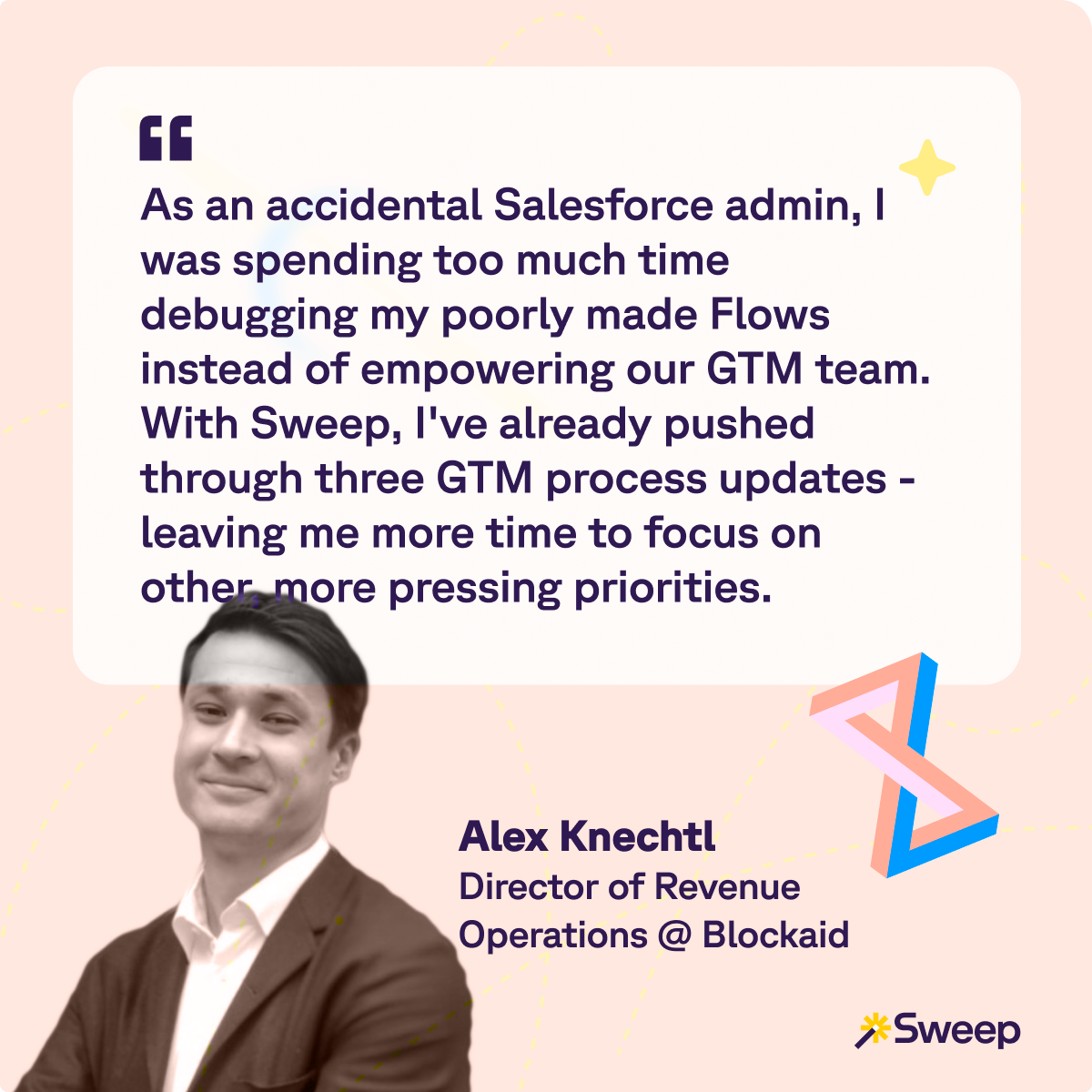When you’re working as an early RevOps hire at a start up, you may be tasked to take on other responsibilities outside of your original job description. This frequently happens when the company is starting to build their technical infrastructure by implementing Salesforce, but maybe doesn’t have the resources necessary to staff up accordingly. And so the RevOps team may be tapped as a placeholder to own, manage, and maintain the platform until additional headcount becomes available.
While becoming an “Accidental Admin” of Salesforce can be challenging, it’s also an incredible opportunity to learn about the business processes from the inside out while also staying in control of the real-time data points that leadership will rely on to make strategic decisions moving forward. We sat down with Alex Knectl, Head of Revenue Operations at Blockaid, to learn more about his experience as an “Accidental Admin” and how he discovered managing Salesforce can unlock endless professional opportunities.
Getting started with Salesforce
Hopefully, if you’ve been assigned to be the de facto manager of Salesforce, you’ve had some experience with the platform before. This may mean that you’ve managed a configuration at a previous job, helped with the implementation process, or even worked with a consultant at some point. In Alex’s case, he had spent time in a past role using Salesforce as a previous, larger startup and had managed a transition to Airtable as well. “I had a sense of confidence that I could rely on my scrappy background to take on this new challenge,” Alex explains.
But even if you don’t have any Salesforce experience, don’t panic. First, there are a number of free and readily available resources that you can use to facilitate the learning curve. Salesforce’s Trailhead provides step-by-step guides that enable new users to navigate the platform as well as dedicated YouTube videos like this one from Salesforce Ben that provide useful advice. Plus there are a number of communities like the Trailblazer community or RevOps Co-Op where members can share how they found solutions to similar challenges. Just remember that if you’re looking to become fully certified, it will take roughly 6-8 weeks of your time. And as a team of one, that may not be time you have to spare.
As you kick off your role as an owner of Salesforce, make sure you align with leadership on what they want to get out the platform. And be sure to determine what (if any) processes they had in place beforehand. “The founders were using another CRM as well as spreadsheets to manage our data before implementing Salesforce,” says Alex. “The initial Salesforce build was not tailored to our business processes and everything had been built reactively.” Alex knew that he had to think strategically about adding to the infrastructure in a way that wasn’t going to break in six months when the sales process inevitably shifted.
Taking on Salesforce challenges
As setting up Salesforce is a huge investment for the company, it’s important to spend time planning before taking action. “I scoped out what we would need changed in Salesforce to get started in a month,” says Alex. But he was faced with some important decisions to make. First, he needed to think through which point solutions to use and determine what he needed to build out. Plus, he needed a game plan when it came to tracking email and meetings data. And he was constantly trouble shooting error codes. “ChatGPT actually became my best friend,” Alex says. “But that was before I started using Sweep.”
The biggest shift for Alex happened when he went through his first change set deployment. “After that,” he says, “I knew I was in over my head.” He was experiencing failures with flows, dealing with error messages while still needing to quickly test and deploy to Salesforce. Alex began looking for a solution that would enable him to maintain control over the platform in a way that would not sacrifice all of his bandwidth. Ultimately he discovered Sweep: the AI-powered visual workspace for Salesforce that’s designed to help new and experienced users build, customize and scale on a drag and drop interface.
Optimizing efficiency and productivity with Sweep
”As an accidental Salesforce admin, I was spending too much time debugging my poorly made Flows instead of empowering our GTM team.” says Alex. “With Sweep, I've already pushed through three GTM process updates - leaving me more time to focus on other, more pressing priorities.” Alex began using the AI-powered documentation immediately so he could instantly see what had been built in his company’s configuration. Plus, he knew that he would have a record of everything he built moving forward which allowed him to troubleshoot error messages faster than ever before.

Additionally, Alex has been able to turn his “Accidental Admin” status into a moment of professional growth for himself. While he may not be shifting his career towards a technical role, he’s been able to gain further understanding into all parts of the business which puts him in a stronger RevOps position to pull key strategic insights to support driving revenue.
If you’re interested in learning more about how Sweep can help you manage Salesforce as an “Accidental Admin,” book a demo with a team member today.

